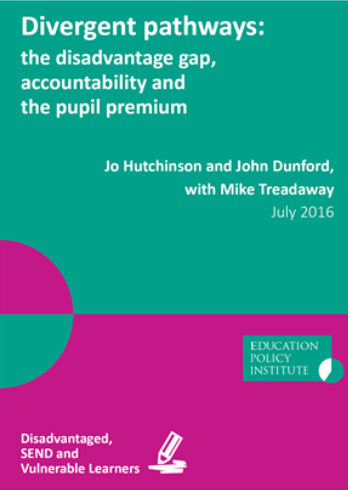Last week over half a million children started secondary school in England for the first time. Their parents will have had the opportunity to apply to their preferred schools the previous autumn. Some parents will have been successful in getting their most preferred school and others will have not.
A new piece of analysis by the Education Policy Institute assesses how parents choose secondary schools and whether this varies for different groups of parents in different parts of the country. Why does this matter? School quality is a key driver of pupils’ later educational outcomes and so it is important to understand the process by which parents choose schools.
We use new national data on all preferences stated by all parents applying for a place at an English state secondary school for entry in academic year 2016/17. This rich dataset allows us to look at three key aspects of school choice:
- the number of schools that parents apply to;
- the quality of those schools based on their Ofsted rating; and
- the likelihood that parents are offered their first-preference school.
Previous research by EPI has shown that Ofsted ratings may not be a good guide to the academic performance of a school, especially for schools with challenging intakes. [1] However we also know from other research that Ofsted is a key source of information for parents when prioritising schools so is highly relevant for our analysis. [2] Our research reveals that there is clear variation in the school choice system by geography, ethnicity and to a lesser extent, by pupil premium eligibility.
Number of Applications
Nationally we find that one-third of parents express only one preference – this is the most common response – and only 28% state the maximum number of preferences allowed by their local authority.
When considering the number of preferences for different demographic groups, there are also key differences. White British families, those with English as a first language and parents of children with low prior attainment are more likely to express a preference for just one school. By contrast there is little difference in the number of preferences by income level, based on pupil premium eligibility. These findings are consistent with previous research for an earlier cohort[3].
However from our first-look at the data we cannot say why some parents apply to fewer schools than others. It may indicate less engagement with the admissions process, but it might also reflect some families having fewer acceptable options or being confident that they will be offered their first preference – for example due to siblings or applying to a school with spare capacity.
Ofsted rating of First Preference School
The number of preferences tells us nothing about their quality. Using Ofsted ratings as a proxy, we see that most parents (52%) apply to a good school as their top preference, with a further 30% nominating an outstanding school. Yet one-in-six parents (17%) have a most preferred school that is rated as less than good by Ofsted and of these, over one-quarter (27%) do so despite having a good or outstanding school as their nearest school. Whilst this is only a small group nationally (around 5%), we see that families eligible for the pupil premium are much more likely than others to fall into this group.
It is puzzling that some parents bypass their good local school in favour of a less good further away – what is going on? One possible explanation is that some parents might be making strategic decisions based on their likelihood of gaining admission. We find that parents who bypass their good local school and nominate a less good one further away are around 10 percentage points more likely to be offered this school than the national average. The possibility of strategic behaviour highlights an important caveat with the preferences data: they cannot be taken at face value as parents’ genuinely preferred schools. Understanding how parents respond to Ofsted ratings when choosing schools is an area in which we are planning further research.
Likelihood of being Offered First Preference School
Perhaps our most striking findings relate to the likelihood of parents being offered their first preference school. Nationally success rates are high with 84% of parents offered their first preference school. But as with the number of preferences, we see marked geographic differences. Virtually all parents in some areas – such as Northumberland (99%), Central Bedfordshire (99%) and Cornwall (98%) – are offered their first preference. At the other extreme, the local authorities with the lowest proportion of parents being offered their first preference are the inner London authorities of Hammersmith and Fulham, (53%) Westminster (54%) and Lambeth (58%). Of the 20 local authorities with the lowest likelihood of being offered first preference, 19 are in London – with the exception being Birmingham (69%).
5% of parents miss out on all of their top three preferences nationally but there are 24 local authorities where this share exceeds 10%. The highest prevalence is in Hammersmith and Fulham, where one quarter of parents (25%) miss out on their top three, followed by 19% of parents in Westminster and 17% in Kensington and Chelsea. 18 of the 24 local authorities are in London – the rest comprise Thurrock (12%), Birmingham (12%), Bradford (11%), Gateshead (11%) North Tyneside (11%) and Slough (10%).
There are also some clear demographic differences. We find that nationally, 90% of white British parents are offered their most preferred school compared to only 66% of black parents; by contrast there are only modest differences by pupil premium eligibility. However these raw gaps can be misleading as they fail to take into account factors like school quality or local context.
As a simple way to address this, we focus on just those parents whose most preferred school is good or outstanding and who live in London. We find that among these parents, white British families are 4 percentage points less likely than black parents to apply to a good school yet when they do so they are 19 percentage points more likely to be offered their most preferred school. Pupil Premium families also face a lower chance of being offered their most preferred good school, though these gaps are smaller than between ethnic groups.
The reason for these gaps is not clear. It is possible they reflect certain groups living further away from good schools which curtails their opportunities because of the use of proximity in school admissions. Yet this cannot be the full story as recent research taking distance into account similarly finds clear differences in admission rates between ethnic groups living in London and other big cities. [4]
Further Research
We are planning further research to better understand how and why there are differential applications to – and offers from – good schools among different groups and whether the gaps we see in London exist elsewhere in the country. This will build on earlier EPI work which showed there is unequal access to good schools among pupils with different characteristics.[5] Understanding the relative roles of parental preferences and school admissions is important from a policy perspective in equalising access to good schools.
If you would be interested in supporting this work, then please get in touch with Emily Hunt (Senior Researcher) at Emily.Hunt@epi.org.uk


